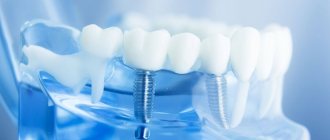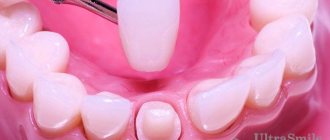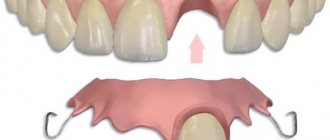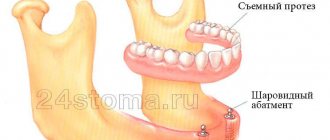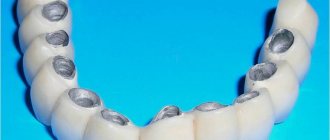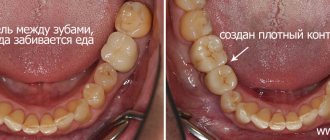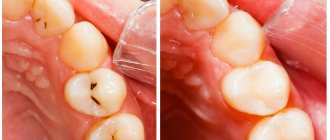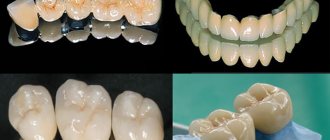General overview
Metal-ceramic crowns are dental orthopedic structures consisting of two structural parts - a frame and a ceramic coating.
The one-piece frame is made according to an individual cast from chromium-nickel or chromium-cobalt alloy, with a thickness not exceeding 0.5 mm. Often other, more expensive metals such as gold, platinum or palladium are used to make the skeleton.
These metals significantly increase the overall price of the product, but improve some of its characteristics.
Using a special technology, the top of the frame is covered with several layers of ceramic mass, and the thickness of the overall coating depends on the type of unit being restored.
Experts, taking into account all the characteristics of metal-ceramics, recommend installing them in the frontal area of the dentition in cases where the use of filling materials or other restoration methods is not possible.
Crowns allow you to cope with dental defects of varying sizes and complexity , even to hide complete edentia. They represent a successful compromise of such indicators as reliability, high aesthetics, durability, comfort and safety.
German ceramics (Vita, Duceram), Japanese ceramics (Noritake).
05/14/2015 The basis of any metal-ceramic structure is a frame, which is covered with ceramic mass. The use of various ceramic masses depends on the manufacturing method and the composition of the frame. Previously, frames were made only by casting (nickel-chrome), in which a dental technician manually fit the cast frame onto a model. With the advent of CAD/CAM technologies, it became possible to ideally fit the frame of a future prosthesis on ground teeth. The micro-precision manufacturing and fit of such a frame makes it possible to use high-tech ceramic masses to obtain the maximum cosmetic effect. This technology is used in the manufacture of frames using laser sintering (cobalt-chrome) and milling (cobalt-chrome, zirconium dioxide). Depending on the choice of the frame of the future prosthesis, we use different ceramic masses: Duceram, Noritake, Vita. Duceram
(Germany) - produced since 1985. A universal ceramic mass that can be used without problems on all high-temperature alloys and has proven itself in cosmetic and clinical aspects. Does not change color when applied to frames made of inexpensive alloys. Allows you to achieve excellent functionality and aesthetics in metal-ceramic prostheses at relatively low cost. Can be used for cladding cast frames. We use Duceram in the manufacture of metal-ceramic prostheses:
-metal-ceramic crown (nickel-chrome casting) -6200 rub. -metal-ceramic crown (cobalt-chrome casting) -6800 rub. -metal-ceramic crown (cobalt-chrome, Germany) laser sintering CAD/CAM. -7500 rub. __________________________________________________________________________________________________________________
Noritake
(Japan) - the company produces porcelain products and has existed for more than 90 years. Since 1987 he has been engaged in research in the dental field. Noritake ceramics are distinguished from other ceramic masses by their stability because their coefficient of thermal expansion does not actually change after repeated firings and, due to this, microcracks practically do not occur. There is also particularly high strength, exceeding by 30% the requirements of the international standard ISO 9693 for dental metal-ceramics. Resistance to the environment and color change is another feature of Noritake porcelain. In Noritake ceramics, one of the world's most famous dental technicians, Hitoshi Aoshima, was the first to develop and implement the internal staining technique. This ceramics makes it possible to carry out dental restorations on high-quality frames with increased requirements for aesthetics. Used on metal-ceramic prostheses with a ledge (zirconium dioxide, laser sintering). Prosthetics using Noritake ceramic mass: - metal-ceramic crown with a ledge (casting cobalt-chrome) - 8200 rub. -metal-ceramic crown with a ledge (cobalt-chrome, Germany) - 9,000 rubles. laser sintering CAD/CAM. -crown based on zirconium dioxide (Germany) CAD/CAM, with ceramic lining - RUB 15,500. _____________________________________________________
Vita
(Germany) - the very first metal-ceramic system in Europe, existing since 1962. Vita ceramic mass belongs to the premium class, as does Noritake. The technique of internal coloring is also used here. But Vita is of natural origin, unlike the synthetic Noritake, and therefore contains more natural shades of tooth enamel, and having a hardness coefficient similar to that of healthy teeth, it allows you not to wear off or injure antagonist teeth when chewing. Metal-ceramic crowns made from Vita are very durable and have the best aesthetic qualities. Ideal for the manufacture of metal-ceramic structures on milled frames (CAD/CAM). Metal ceramics using Vita porcelain mass:
-metal-ceramic crown with a ledge (cobalt-chrome, Germany) – 12,500 rubles. CAD/CAM milling.
To choose a design, consult our orthopedic doctors.
Make an appointment
A little about the manufacturer
Today, more and more patients at dental clinics prefer to get German “Duceram” crowns for metal-ceramic prosthetics.
The company first began producing these structures in the mid-80s of the last century, and to this day remains a leader in the production of high-quality crowns and prosthetic systems made of metal-ceramics.
At a relatively low price, the ceramic mass of the same name makes it possible to produce a crown that has excellent aesthetic and technical characteristics.
Teeth restored with such products last a long time and always look natural.
Product Features
Duceram crowns are considered the most modern and reliable of all analog ceramic products, since this model uses a special type of metal-ceramic with shoulder mass. Their main feature is the thinning of the metal layer and thickening of the ceramic layer.
This production technology significantly influenced the result of prosthetics, namely:
- in the area of the neck of the tooth, the gums no longer darken;
- the edges of the frame are not visible;
- the crown itself looks more aesthetically pleasing;
- strength increases significantly;
- service life is extended.
The manufacturing procedure itself has slight differences from the generally accepted one - otherwise the teeth are ground down for a crown (i.e., a rounded stump is created) and the proportions of the materials used in the alloys change.
About the advantages of titanium crowns and indications for their use.
Read here about proper preparation of teeth for metal-ceramic prosthetics.
At this address https://www.vash-dentist.ru/protezirovanie/nesemnyie-p/koronki-np/dostoinstva-farforovyih.html we will talk about the advantages of installing porcelain crowns on the front teeth.
Front tooth veneer
Once the ceramic shoulder has been formed, the framework can be veneered with Deep Dentin. It is applied to the entire surface of the frame and lengthens it by 1–1.5 mm.
This ensures that the edge of the frame is invisible and creates a soft transition from the opaque metal frame to the translucent area of the cutting edge.
Since the preparation of a groove-shaped shoulder removes a fairly significant amount of hard tissue, especially in the central part of the crown, a relatively thick layer of base-colored dentin is applied to this area.
In the area of the cutting edge, the shape of the crown is restored with a lighter dentin mass. With the help of these 3 masses, a primary and relatively rough restoration of the final shape and dimensions of the tooth is carried out, in particular its length, width, axis position and facet arrangement. The cutting edge is modeled entirely from dentin.
The applied layers of ceramic are then moderately compacted and the dentin crown is prepared for the application of incisal materials.
To do this, part of the dentin on the labial surface from the side of the cutting edge is removed approximately half the thickness of the applied layer and approximately to the middle of the crown.
As a result, a dentin base is formed on the palatal side, on which the individual elements of the dentin layer in the area of the incisal edge are modeled.
In this case, 3 mamelons are modeled on the dentin base in the area of the incisal edge using Deep Dentin mass.
In other situations, you can use special mamelon masses that are included in the system. Since the ceramic masses shrink not only in height, but also in width, the outer mamelons are located slightly closer to the lateral edges of the crown.
The tops of the mamelons should protrude slightly above the incisal edge of the crown. To reproduce the effect of optical depth, a transparent mass is applied over the mamelons.
This layer should completely cover the mamelons from the labial surface and extend slightly onto the palatal surface. After a short drying of the veneer, it becomes more stable and holds its shape better, which makes it possible to reduce the thickness of the dentin layer near the incisal edge on the palatal side in a relatively easy and controlled manner. Then this area is also lined with a transparent mass.
To highlight the mesial and distal edges of the labial surface of the anterior tooth and make them lighter, a white opalescent mass is applied to them.
A wide transverse strip between them allows you to slightly reduce the color saturation of dentin. After removing the crown from the model, a translucent mass is applied to the mesial and distal contact areas.
In this condition, the crown is sent for the first dentin firing. At this stage we have completely formed the dentin base, modeled the mamelons, applied an intermediate transparent layer and imitated the lighter opalescent areas, but have not yet used the mass for the incisal edge.
The great advantage of the stage-by-stage cladding technology is the ability to control the results of the previous stage. This primarily applies to special effects, for example, mamelons, which, due to the shrinkage of the ceramic after firing, may be too short or, conversely, too long. In addition, after the first firing we can check the dimensions and effect of the transparent layer and, if necessary, adjust them. At the same time, control and correction of the quality and density of proximal contacts is carried out.
Before the second firing, the crown is covered with base-color dentin and incisal material. In this case, we are talking mainly about correcting the shape, since the reproduction of color and individual characteristics has already been completed.
The amount of applied masses is quite large. Therefore, the second firing is also carried out at maximum temperature. After this firing, we see that the restoration of the tooth shape is also almost complete.
The finished crown should be as accurate a copy of the natural tooth as possible. The final mechanical correction of the crown shape, as well as the formation of an individual surface texture, is carried out using small torpedo-shaped stones with green markings. These tools produce a very soft abrasive pattern and are well suited for creating both flat and more defined surface textures.
Minor correction of the crown shape is carried out using a mixture of cutting edge mass and low-temperature Add_on_mass. To correct the ceramic shoulder, a mixture of dentin, a small amount of Add_on_mass and special wax is used. This mixture is applied using an electric wax scalpel; after modeling, the excess mixture is carefully removed.
During the firing process, the wax burns out without a trace. This technology ensures very good results. After firing, all corrected areas as well as edges are polished by hand.
As always, when making a metal-ceramic restoration, a very important task is to create a soft (in color and brightness) transition between the areas located at the level of the opaque metal frame and the area of the incisal edge. The optimal combination of opaque compounds and other facing materials of the IPS InLine system allows us to successfully solve this and many other problems.
Covering the chewing tooth
The same ceramic masses are used to veneer the chewing tooth. Unlike the anterior tooth, the Cut_back_technique is not used when veneering a chewing tooth. Individual masses are applied according to a similar pattern.
First, a thin layer of Deep Dentin is applied to the frame. At the same time, due to the formation of protrusions in place of the tubercles, its height increases by 1–1.5 mm.
Then the frame is lined with two dentin masses of the main and lighter shade of color, and in this case, not the full anatomical shape of the tooth is modeled, but only the dentin base. In the area of the equator of the tooth, it has a maximum thickness, and the dentin projections are modeled narrow enough to maintain space for applying masses for the incisal edge. The slopes of the cusps should only be indicated, since their final structure is modeled later using the incisal mass.
By analogy with the front tooth, the dentin base is covered with a layer of transparent mass to form the required optical depth. The thickness of this layer can be used to adjust both the optical depth and the brightness of the base color of the crown.
Finally, some important structural elements, such as the tips of the cusps and crista transversa, are emphasized with white opalescent Opal Effect 4.
After firing, the elements of the morphological structure of the occlusion surface are emphasized with special dyes, due to which the relief of the finished crown visually becomes more pronounced. The dyes are fixed at low temperatures (about 700°C), which prevents them from “blurring” during subsequent cladding. This technique was developed many years ago by a famous Japanese master.
It allows you to effectively imitate or emphasize certain local effects.
Before the second firing, the central part of the crown is covered with dentin material of base color A2, and in the area of the occlusal surface with incisal material I2. At this stage, specific morphological elements of tooth 26, as well as functional structures, are formed. Due to the large amount of mass applied, the second firing, as for the front tooth, is carried out at maximum temperature.
To model the complex structure of the occlusion surface, a special tool is required. Deep fissures are modeled using pointed carbide instruments (“Stegerspitze”), the results of which are clearly visible after firing. After grinding the functional facets, the slopes of the tubercles are smoothed with small stones, deep areas of the relief are processed with a diamond tool with a spherical or pointed working part. The final correction of the shape of the outer surfaces of the crown is carried out with stones with green markings. The silky-matte surface is formed during processing with abrasive discs with polymer bristles. This is followed by a glaze firing. Due to the high density and surface quality of InLine_ceramics, this firing can be carried out without the use of glazing material.
Advantages and disadvantages
The popularity and growing demand for German cermets is explained by the following advantages:
- Safety - all materials taken for production do not contain toxic compounds that are hazardous to patient health.
- High aesthetics - in shape and shade of ceramics, a high-quality product is identical to natural dental units
- Long service life - approximately 12-15 years.
- Strength, wear resistance , resistance to temperature fluctuations, minimal abrasion.
- Hygiene - pathogenic microflora and deposits do not accumulate on them.
- Biocompatibility – there is no discomfort, changes in tissues and oral mucosa.
- Accessibility for most patients.
- Easy to care for - to maintain their appearance and functionality throughout their wearing, daily cleaning is usually sufficient.
- Practicality and functionality - in a short period of time they normalize chewing and speech functions, and the material itself makes it possible to very accurately repeat the features, color and shape of the restored elements.
- Short adaptation period.
Well-installed structures protect the coronal parts of anatomical units well from further destruction.
With such numerous advantages, Duceram has several significant disadvantages. These include:
- Ceramics, experiencing constantly increased mechanical stress, can crack.
- Cannot be bleached like natural units.
- Prosthetics involves grinding healthy teeth, which negatively affects their condition.
- Grinding can burn the pulp, which will subsequently lead to its inflammation and death.
- In very rare cases, an allergy to one of the frame metals occurs. Its first symptoms are swelling of the mucous membrane, rancid taste, and burning sensation.
- Rapid abrasion of units adjacent to the crown, which is explained by the increased density of metal-ceramics.
Important! The manifestation of even one named symptom is a reason to immediately seek medical help.
Indications and contraindications
Dentures from a German manufacturer are installed to restore aesthetics, anatomy and chewing function to elements of the dentition in the presence of the following problems:
- lack of several or only one element;
- significant destruction of the coronal part;
- the presence of defects that cannot be hidden with veneers or restoration with composites;
- extensive caries;
- loss of shape;
- high enamel abrasion;
- pronounced deficiency in the formation of hard tissues;
- fluorosis;
- periodontal disease of initial and moderate degrees;
- change in enamel color that cannot be corrected by a professional procedure;
- after splinting teeth.
The characteristics of the material itself and the technology of grinding teeth impose a number of restrictions on prosthetics. It is not recommended to install products in the following cases:
- incorrect occlusion;
- low height of the coronal part;
- instability of supporting teeth (their looseness);
- severe periodontal problems;
- significant thinning of the enamel layers;
- bruxism;
- allergy to any metal.
Important! If there are these contraindications, the doctor will offer the patient an alternative replacement method instead of metal ceramics.
Preparation for prosthetics
Before prosthetics, a set of special and general health procedures must be carried out. It all starts with an examination of the oral cavity by a dentist and his consultation.
When examining the patient, the specialist pays special attention to the condition of the bite, mucous membrane, bone tissue, and each element of the dentition, identifying problematic ones.
Based on the results of such an examination, the doctor determines the limitations/indications for performing metal-ceramic prosthetics, develops a treatment plan for the detected diseases and prepares the person for the placement of crowns.
To obtain more extensive information about the state of the dental system, the specialist prescribes an orthopantomogram - obtaining a panoramic image of the jaw, which allows you to determine:
- pathologies that are not visually detectable;
- quality of old fillings;
- inflammatory focus (if any);
- state of root canal filling.
Important! An orthopantomograph examination is an absolutely safe procedure for the patient and does not cause discomfort or pain. Before the examination, you must remove all jewelry from your head and neck.
At the next stage of preparation, complete oral hygiene is carried out, including:
- removal of subgingival deposits;
- cleaning dirt and plaque from interdental crevices and enamel;
- polishing of all elements of the dentition and coating them with a composition containing fluoride components.
Caries, inflammation, and periodontal diseases must be treated. Special attention is given to those units on which crowns are supposed to be placed; old fillings are replaced with new ones.
If unstable teeth are found in the mouth, they are splinted, i.e. reinforced with special tires. Elements that are not of particular functional significance are subject to extraction.
The most important step in preparing the mouth is grinding down the teeth on which the crowns will be placed, each of them being given a cone shape.
The procedure is now carried out under local anesthesia using special equipment and instruments. First, the nerve is removed, and then the tooth is ground down 2 mm on each side.
At the end of the preparation, the dentist creates a ledge (for Duceram its value is 1.0 mm) and puts on a temporary plastic crown. It is this that will protect the tooth from external factors and preserve the overall aesthetics of the dentition.
In order to make a high-quality orthopedic structure, at the preparatory stage an imprint of the tooth or the entire dentition, called an impression in dentistry, is taken. To obtain an impression using the standard method, an impression tray and a mass made on the basis of wax and alginate material are taken.
Most large clinics have long ago abandoned this procedure and began to use more modern technology for obtaining an impression - scanning. For the patient, everything goes quickly and with minimal discomfort. In addition, a 3D image allows the doctor to examine in detail all areas of the impression.
Why is it advisable to install suture artificial crowns in rare cases?
This publication is all about taking impressions of teeth for prosthetics.
Here https://www.vash-dentist.ru/protezirovanie/nesemnyie-p/koronki-np/stalnyie-na-zubyi.html all the most important things about steel crowns on teeth.
Description of a clinical case
A little over a year ago, temporary long-term restorations with a metal frame were installed in the patient’s mouth. This time is quite enough for complete tissue healing after lengthening the clinical crowns, testing a new bite and correcting the structure of the front teeth in accordance with the individual wishes of the patient.
Teeth preparation was carried out at the stage of preparation for the manufacture of temporary restorations. However, due to some phonetic problems (feeling that the tongue is too large), additional control of the size of the crowns and stumps of the teeth was carried out. It was found that the stumps of the first premolars of the upper jaw are too large in the bucco-palatal direction. Additional preparation of these teeth was performed before making the final impression.
Based on the impression, an accurate model is cast, which provides an ideal basis for the production of precision frames. The frameworks are modeled using a silicone template made from long-term temporary restorations and cast using classical lost-wax casting technology from a high-gold alloy. On the labial side (2/3 of the perimeter) it is planned to make a ceramic shoulder.
To better understand the layering technique that was used in this case, below we will consider in detail, step by step, the veneering technology of two demonstration crowns.
The preparation area of tooth 21 ends with a relatively flat groove-like shoulder, which makes it possible to form a ceramic shoulder no more than 2 mm high. To do this, the metal frame, cast from Ivoclar Vivadent's high-gold fire alloy, must be shortened accordingly.
The metal frame is prepared in strict accordance with the manufacturer's recommendations and, after oxidative firing, acquires a uniformly oxidized surface.
The thickness of the oxidized layer decreases during sandblasting. After thoroughly cleaning the surface, the frame is covered with an opaque layer. The best results are achieved by sequentially applying 3 thin layers of paste opaque, which is part of the selected ceramic veneering material system.
Opaque materials can be supplied in single doses, which helps prevent the paste from separating. A more saturated (dark) opaque mass is applied to areas of the palatal surface and the occlusal surface, where the thickness of the layer of facing materials is minimal. In this way, you can slightly reduce the brightness and increase the color density without distorting the color combination chosen for a complex restoration. Another useful modification to the standard opaque material is the increase in fluorescence intensity, which is achieved by adding “F-paste”. This allows you to increase the “saturation” and depth of color.
The formation of a ceramic shoulder is carried out using traditional technology. Applying a bead-like layer, the thickness of which gradually decreases from the edge to the middle of the crown, allows for the best possible control of shrinkage and prevents the formation of cracks.
This technique is based on the well-known fact that ceramics shrink in the direction of the center of mass. 2-3 firings allow you to form a precise shoulder with an optimally shaped edge, which no longer requires additional attention, up to the glaze firing. Cervical masses are characterized by high fluorescence intensity. Each dentin mass has its own cervical mass with a slightly warmer shade of color that blends well with the color of the dentin.
Demonstration veneer - anterior tooth
For complete veneering of the crown, 6 ceramic masses are required. These masses are quite sufficient for lining any extended restoration. In the absence of surviving natural teeth to use for comparison, they ensure that a harmonious aesthetic appearance is achieved. For veneering single crowns that will be integrated into the natural dentition, this set of masses is not enough.
This set contains the following 6 masses:
- IPS InLine Deep Dentin A2
- IPS InLine Dentin A2
- IPS InLine Dentin A1
- IPS InLine Transpa neutral
- IPS InLine Opal Effect 4
- IPS InLine Incisal 2
Deep Dentin
Deep Dentin masses are sufficiently opaque to form a reliable base for dentin in a thin layer and give it the necessary depth. The color of these masses is more saturated than that of dentin. Therefore, they are recommended for use in the cervical areas, on the palatal surface and on the occlusal surface.
Dentin
On top of the Deep Dentin layer, a dentin base is formed from two dentin masses of different colors. This combination allows you to optimize the color of the dentin layer. A base color mass is applied to the cervical areas and the central part of the crown, and a lighter color mass is applied to the incisal edge area.
Transpa neutral
A transparent layer is formed between the dentin base and the incisal layer. The dimensions of this layer determine the transparency of the cutting edge area. In addition, it separates the flow of light reflected from the surface of the dentin and from the outer surface of the restoration, due to which it acquires optimal optical depth.
Opal Effect 4
This mass allows you to reproduce the effect of white opalescence on the edges of the enamel. It shouldn't be too noticeable. In addition, this mass can be used to emphasize certain morphological characteristics and to separate areas of the tooth with different brightness, for example, in the area of \u200b\u200bthe edges, in the form of a wide transverse stripe or in the area of the cusp tips of chewing teeth.
Incisal 2
Incisal 2 incisal material is much less transparent than Transpa Incisal 2. If you work primarily with transparent materials in the incisal area, then the use of Incisal 2 allows you to create a soft transition to the central part of the crown and emphasize the individual characteristics of the incisal area.
Installation
Manufacturing and installation of the Duceram prosthesis is a very complex process and takes place in several stages:
- Based on the impression, a model is made from dental plaster - a copy of the reconstructed unit.
- The future base (frame) is modeled from wax.
- The frame is cast according to its model.
- The product is tried on, and if there are no shortcomings, it is transferred to the workshop for further work.
- The first layer of Duper-mass - opaquer - is applied to the frame. It is applied with a special brush to obtain a uniform coating.
- Burning is carried out.
- A second sponge layer of shade is applied that exactly matches the individual color of a person’s teeth.
- The product is fired again.
- A third layer is applied - dentine mass to reproduce the desired anatomical shape of the tooth. The resulting product has a slight discrepancy with the size of the original. But after firing the mass shrinks a little.
- A fourth layer is applied - enamel, the color of which imitates the shade of your own teeth.
- The crown is sent for firing. The product is ground and polished, the shape is corrected with a special layer, the next firing and glaze are applied. The product undergoes final firing.
Before placing the finished crown on the tooth, it is treated with an antiseptic solution and paste with fluoride to prevent its destruction under the structure.
To find out how comfortable the patient will be in the crown, whether it will cause inconvenience when talking and eating, it is initially secured with temporary cement.
If after a week the patient does not make any complaints, the structure is removed, cleaned and finally fixed with dental cement.
The video explains in more detail about Duceram metal ceramics and the modeling principle.
Dental prosthetics. Metal ceramics, how different they are
Metal ceramics 90 USD!!! . . Ceramic metals are cheap!!! Metal ceramics VIP!!!
What does all of this mean? What kind of different metal ceramics are these? After all, metal-ceramics and Africa are also metal-ceramics; how do metal-ceramic crowns differ from each other?
The technological process of manufacturing a metal-ceramic crown consists of the following stages:
1. Making plaster dismountable models for making crowns
2. Modeling future wax frames
3. The process of casting frames from dental alloys
4. Processing of the metal frame and precise fitting (fitting) on the model in the dental laboratory
5. Applying ceramic mass to the resulting frame.
6. Correction in color and shape after fitting in a dental clinic directly in the patient’s mouth.
It is no secret that for each stage there are many materials, as well as technologies for obtaining the final result. There are a lot of options here that none of the patients know about, even many doctors don’t know, talking only about ceramics: Japanese, German, American ceramics, and if in one clinic Japanese ceramics NORITAKE is the most prestigious and expensive, and American FINESSE is much more cheaper for the patient, then in another - everything is completely different, for some reason the best ceramics turns out to be German DUCERAM PLUS.
And all this is only because dental technicians prefer to work with one ceramic mass, learning the secrets of application, mixing, tinting, and creating transparency. A starter set of ceramics is not cheap and, having thoroughly racked his brains over choosing it, the dental technician buys a set for several thousand. and until this raw material runs out, it is unlikely to acquire another mass.
And orthopedic dentists prefer to work with only one dental technician, together with him, achieving the best results as much as possible, based on personal professional skills and theoretical knowledge.
Sometimes, one of this duo goes far ahead and is no longer satisfied with the quality of the other’s work. The dental technician no longer takes impressions from the doctor, saying that they are of poor quality and that he will not be able to make a high-quality crown using such impressions. And sometimes the prosthetist returns to the laboratory newly made crowns that do not suit him in many respects, breaking off the working relationship with the dental technician due to the latter’s low qualifications.
What does the technician not like about the doctor’s work?
- Poor, inaccurate processing (turning) of teeth, lack of parallelism of processed teeth.
- Low quality of the impression, from which all important elements of the processed tooth cannot be read.
- Unrealistically short lead times for making crowns.
What doesn’t an orthopedic dentist like about working as a technician?
- Low, or better said, lack of precision in the manufacture of crowns.
- The crown does not match in color or shape with the patient’s adjacent natural teeth.
- Very thin (less than 0.3 mm) crown frames.
- The presence of holes, internal voids (cavities) in metal frames.
- Large errors in modeling the height of the crowns - during fitting, you have to “remove” the entire chewing surface of the metal-ceramic crown with a diamond bur.
- Presence of metal dust inclusions in sintered ceramics.
- Delay in the production of metal-ceramic crowns.
Comparative characteristics of metal-ceramic crowns:
| metal ceramics 250 USD | metal ceramics 350 USD | metal ceramics 500-700 USD | metal ceramics from 1000 USD and higher |
| NiCr frame | NiCr frame | Frame NiCr, CoCr | CoCr frame |
| Plaster models are cast from hand-mixed plaster | Plaster models are cast from hand-mixed plaster | Plaster models are cast from hand-mixed plaster | Plaster models are cast from plaster mixed in a vacuum mixer |
| The foundry laboratory is located in the state. clinic, the cost of casting is “penny” | In the state clinic or laboratory under a cooperation agreement | Foundry laboratory under a cooperation agreement or own laboratory | Own foundry laboratory |
| Materials (metal) for the manufacture of domestically produced frames | Domestic production 50%, imported production 50% | All materials for the manufacture of frames are imported | All materials are imported |
| Imported ceramic mass | Imported ceramic mass | Imported ceramic mass | Imported ceramic mass |
| Dental technician experience from 0 to 2 years. No artistic skills | Dental technician experience 1-4 years. Artistic skills are poorly developed | Dental technician experience 3-7 years. He can do some work “very well”, but no more | Work experience of 5 years. The dental technician is an artist, he knows all the secrets of ceramic mass, all his work is excellent. |
| There is no separate room for applying ceramics to frames. | Not in 80% of laboratories, present in 20% of laboratories. | Yes 100% | Yes 100% |
| Existence of a hood - no | Existence of a hood - no | Existence of a hood - yes | Eat |
| Kiln for firing ceramics, domestic or imported, with a long service life | Imported | Imported | Imported, latest equipment |
| Volume of crowns produced by a dental technician (units/month) 200-300 | 200-400 | 150-200 | 30-80 |
| Work only in the occluder | Work only in the occluder | Can be occluder and articulator | Articulator only |
| Working with a facebow - no | No | No | Only with facebow |
| Temporary crowns on teeth during the period of making permanent crowns – no | There are temporary crowns in 50% of cases | Temporary crowns are required | Temporary crowns are required |
| Crowns are made on teeth prepared without a ledge | Without ledge; With a ledge - 30% | Only with ledge | Only with ledge |
| Nobody even thinks about the precision of crown manufacturing | Satisfactory precision in crown manufacturing | Good accuracy - 60-70% Ideal accuracy -30-40% | Perfect precision in crown manufacturing |
| Presence of metal dust in ceramics – yes | Presence of metal dust in ceramics – yes | There is no metal dust in ceramics | Presence of metal dust in ceramics – no |
| Frequency of chipping of ceramic mass ~ 90% | Frequency of chipping of ceramic mass ~ 50% | Frequency of chipping of ceramic mass ~ 20% | Frequency of chipping of ceramic mass ~ 0-5% , |
Rules of care
Duceram crowns are easy to care for. The basic rules for caring for them do not differ from generally accepted recommendations for caring for analogue structures from other manufacturers:
- Cleaning of crowns takes place simultaneously with brushing your teeth according to the same rules - twice a day for at least three minutes. with the only limitation - the paste should not contain abrasive components.
- Include the use of additional hygiene devices and disinfectants: rinse aid, floss, irrigator, dental brush.
- Do not gnaw or bite off hard or hard foods, and protect crowns from accidental damage.
- Visit your dentist at least twice a year for examination and treatment of any problems found.
Important! All of the above recommendations will help avoid problems with the oral cavity and prolong the life of the crowns.
Life time
They are certified to have a service life of 10 years. But as practice shows, if hygiene rules are observed and treated with care, this period is extended for another 3-4 years.
If you use any of the noble metals for the frame of the structure, the service life increases to 15 years or more.
Price
The total cost of metal-ceramic prosthetics directly depends on the complexity of the case, the number of teeth being reconstructed, the number of examinations and treatment measures carried out before prosthetics, as well as on the materials chosen for the manufacture of the frame.
An example of the cost of one Duceram crown is presented in the table.
| Material | Cost in rubles |
| Nickel-chromium alloy without shoulder formation | 5 000 |
| Nickel-chrome alloy with shoulder | From 7 500 |
| Nickel-chrome alloy with shoulder mass | About 8,500 |
| Laser sintered cobalt-chromium alloy without shoulder | From 10 000 |
| Cobalt-chrome alloy with shoulder mass | About 11,000 |
If the frame is made of precious metals, the total cost will almost double. You will also have to pay separately for the cost of making a temporary crown.
How long does it take to place a metal-ceramic crown on a tooth?
The duration of treatment depends on the condition of the teeth that we are going to replace. If the tooth is not bothering you and it’s just time to change the metal-ceramic crown, then you will need 2 visits within 5-7 days. If the tooth has not yet been treated, then two visits within 5-7 days are usually sufficient. If the tooth was previously healed, replaced with prosthetics and began to bother you, then you will first have to re-treat it, and only then make and install a new crown. During treatment, the doctor may suggest that you install a temporary crown.
Reviews
Modern prosthetic technologies are at a completely different level than just a few years ago.
Metal-ceramic crowns today are considered the most reliable, comfortable and affordable orthopedic products that help correct many problems of the dental system.
Of all the existing varieties of similar designs, German “Duceram” crowns hold the lead in popularity.
You can talk about your experience and share your impressions of dental reconstruction with these products by leaving a comment on this article.
If you find an error, please select a piece of text and press Ctrl+Enter.
Tags dental crowns metal-ceramic crowns fixed dentures
Did you like the article? stay tuned
Previous article
Eight reasons to choose Elan braces for correcting defects
Next article
Noritake metal-ceramic crown - beauty, elegance, durability
Examples of work “Before” and “After”
Prosthetics of chewing teeth with zirconium dioxide crowns
Case: destruction of the posterior teeth on the upper and lower jaw.
Combination of removable and fixed prosthetics
Case: Partial absence of chewing teeth on the upper and lower jaws, the need for prosthetics of the anterior teeth of the upper jaw.
Metal-ceramic crowns and core inlays
Case: destruction of the front teeth (11 and 21).
Restoration of anterior teeth with Empress ceramic crowns
Case: enamel hypoplasia (underdevelopment of tooth enamel).

